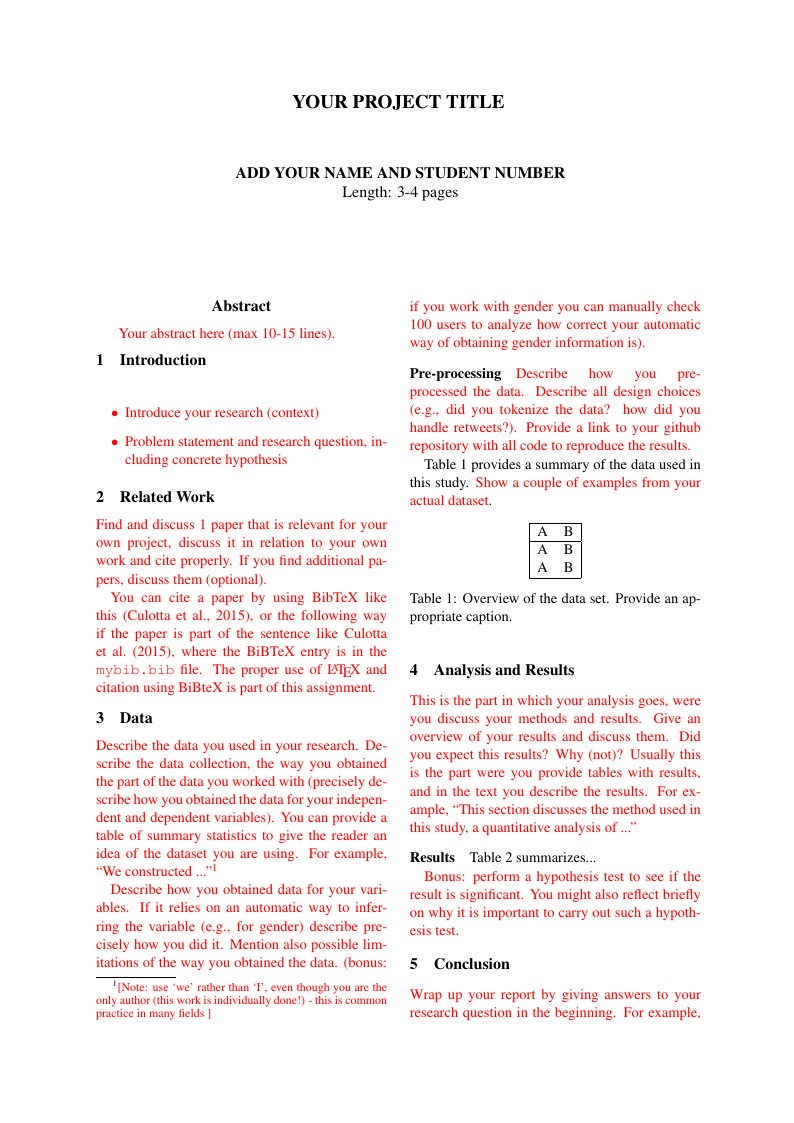
IWO_RUG_BA_IK
Author:
T. Caselli
Last Updated:
8年前
License:
Creative Commons CC BY 4.0
Abstract:
Template for the the final project of the course.

\begin
Discover why over 20 million people worldwide trust Overleaf with their work.
Template for the the final project of the course.

\begin
Discover why over 20 million people worldwide trust Overleaf with their work.
%
% File ACL2016.tex
%
\documentclass[11pt]{article}
\usepackage{acl2016}
\usepackage{times}
\usepackage{latexsym}
\usepackage{url}
\usepackage{booktabs}
\usepackage{graphicx}
\usepackage{color}
\usepackage{amsmath}
\aclfinalcopy
\usepackage[authoryear]{natbib}
\usepackage{url}
\title{YOUR PROJECT TITLE}
\author{ADD YOUR NAME AND STUDENT NUMBER\\
Length: 3-4 pages}
\date{}
\begin{document}
\maketitle
%%% YOUR PART HERE
\begin{abstract}
\textcolor{red}{Your abstract here (max 10-15 lines).}
\end{abstract}
%% IMPORTANT: KEEP ALL SECTIONS (headers)
%% remove the 'red' text parts
\section{Introduction}
\textcolor{red}{
\begin{itemize}
\item Introduce your research (context)
\item Problem statement and research question, including concrete hypothesis
\end{itemize}
}
\section{Related Work}
\textcolor{red}{Find and discuss 1 paper that is relevant for your own project, discuss it in relation to your own work and cite properly. If you find additional papers, discuss them (optional).}
\textcolor{red}{You can cite a paper by using BibTeX like this~\citep{Culotta:ea:2014}, or the following way if the paper is part of the sentence like~\cite{Culotta:ea:2014}, where the BiBTeX entry is in the \texttt{mybib.bib} file. The proper use of \LaTeX{} and citation using BiBteX is part of this assignment.}
\section{Data}
\textcolor{red}{Describe the data you used in your research. Describe the data collection, the way you obtained the part of the data you worked with (precisely describe how you obtained the data for your independent and dependent variables). You can provide a table of summary statistics to give the reader an idea of the dataset you are using. For example, ``We constructed ..."\footnote{\textcolor{red}{[Note: use `we' rather than `I', even though you are the only author (this work is individually done!) - this is common practice in many fields ]}}}
\textcolor{red}{Describe how you obtained data for your variables. If it relies on an automatic way to inferring the variable (e.g., for gender) describe precisely how you did it. Mention also possible limitations of the way you obtained the data. (bonus: if you work with gender you can manually check 100 users to analyze how correct your automatic way of obtaining gender information is).}
\paragraph{Pre-processing} \textcolor{red}{Describe how you pre-processed the data. Describe all design choices (e.g., did you tokenize the data? how did you handle retweets?). Provide a link to your github repository with all code to reproduce the results.}
Table~\ref{tbl:stats} provides a summary of the data used in this study. \textcolor{red}{Show a couple of examples from your actual dataset}.
\begin{table}[hbtp]\centering
\begin{tabular}{|cc|}
\hline
A & B \\
\hline
A & B \\
A & B \\
\hline
\end{tabular}
\caption{Overview of the data set. Provide an appropriate caption.}
\label{tbl:stats}
\end{table}
\section{Analysis and Results}
\textcolor{red}{This is the part in which your analysis goes, were you discuss your methods and results. Give an overview of your results and discuss them. Did you expect this results? Why (not)? Usually this is the part were you provide tables with results, and in the text you describe the results.
For example, ``This section discusses the method used in this study, a quantitative analysis of ...''}
\paragraph{Results} Table~\ref{tbl:results} summarizes...
\textcolor{red}{Bonus: perform a hypothesis test to see if the result is significant. You might also reflect briefly on why it is important to carry out such a hypothesis test.}
\begin{table}[hbtp]\centering
\begin{tabular}{|ccc|}
\hline
A & B & C\\
\hline
A & B & C\\
A & B & C\\
\hline
\end{tabular}
\caption{Add a caption}
\label{tbl:results}
\end{table}
\section{Conclusion}
\textcolor{red}{Wrap up your report by giving answers to your research question in the beginning. For example, ``This study aimed at ..." You might mention limitations of the current study, or directions for further research here.}
%%END YOUR PART
\section*{\textcolor{red}{Check list}}
\textcolor{red}{(in your final paper remove this section)}
\textcolor{red}{
\begin{itemize}
\item Make sure your paper is max 4 pages long
\item check that your paper contains an abstract
\item check that your paper states the research hypothesis
clearly, and defines independent and dependent variables
\item make sure your paper has a related work section were you discuss at least 1 paper that you found relevant to your own work
\item check that your paper describes precisely how you created
the data set that you base your research on, including all steps in preprocessing the data
\item include an overview of the collected data (optionally: show a few examples of the actual data that are used in your study)
\item make sure your paper links to the github repository and that contains all scripts to obtain your results
\item make sure your paper contains an analysis and results section, which shows the results of your study and discusses them (table + text)
\item finally, make sure you have all parts of the report: abstract, introduction, related work, data, analysis and results, conclusion
\item check proper use of \LaTeX{} and BibTex
\end{itemize}
}
\bibliographystyle{chicago}
\bibliography{mybib.bib}
\end{document}